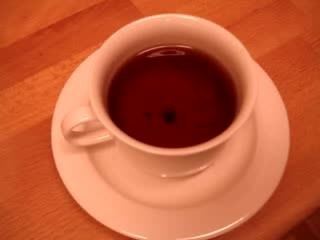 | ||
The tea leaf paradox describes a phenomenon where tea leaves in a cup of tea migrate to the center and bottom of the cup after being stirred rather than being forced to the edges of the cup, as would be expected in a spiral centrifuge. The formation of secondary flows in an annular channel was theoretically treated by Boussinesq as early as in 1868. The migration of near-bottom particles in river-bend flows was experimentally investigated by A.Ya.Milovich in 1913. The solution first came from Albert Einstein in a 1926 paper in which he explained the erosion of river banks, and repudiated Baer's law.
Contents
Explanation
Stirring the liquid makes it spin around the cup. In order to maintain this curved path, a centripetal force in towards the center is needed (similar to the tension in a string when spinning a bucket over your head). This is accomplished by a pressure gradient outward (higher pressure outside than inside).
However, near the bottom and outer edges the liquid is slowed by the friction against the cup. There the fictitious (inertial) centrifugal force is weaker and cannot overcome the pressure gradient, so these pressure differences become more important for the water flow. This is called a boundary layer or more specifically an Ekman layer.
The inertial centrifugal force due to the bulk rotation of the liquid results in the development of an outward pressure gradient within the liquid, where the pressure is higher along the rim than in the middle. This manifests itself as the formation of a concave liquid-air interface. This pressure gradient provides the necessary centripetal forces for circular motion when summed over the entirety of the rotating liquid.
However, within the boundary layers where fluid rotation is slowed by friction and viscous effects, the centripetal force due to pressure gradient is dominant over the inertial forces from rotation, and creates an inward secondary flow within the boundary layer. The flow converges at the bottom of the teacup (where the tea leaves are observed to gather) and flows upwards to the surface. Higher up, the liquid flow meets the surface and flows outwards. The leaves are too heavy to lift upwards and remain in the middle. Combined with the primary rotational flow, the leaves will be observed to spiral inwards along the bottom of the teacup.
Applications
The phenomenon has been used to develop a new technique to separate red blood cells from blood plasma, to understand atmospheric pressure systems, and in the process of brewing beer to separate out coagulated trub in the whirlpool.
